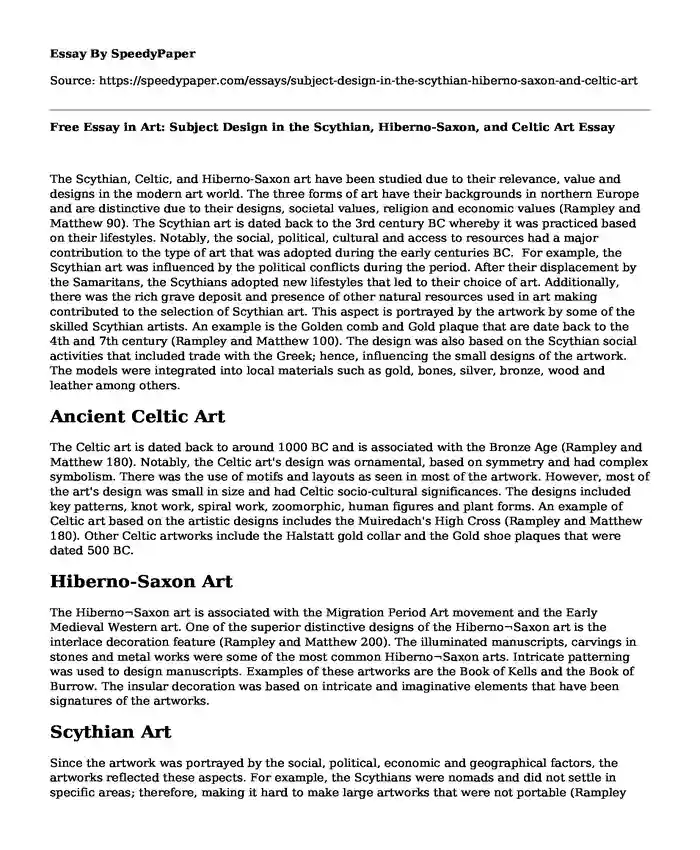The Scythian, Celtic, and Hiberno-Saxon art have been studied due to their relevance, value and designs in the modern art world. The three forms of art have their backgrounds in northern Europe and are distinctive due to their designs, societal values, religion and economic values (Rampley and Matthew 90). The Scythian art is dated back to the 3rd century BC whereby it was practiced based on their lifestyles. Notably, the social, political, cultural and access to resources had a major contribution to the type of art that was adopted during the early centuries BC. For example, the Scythian art was influenced by the political conflicts during the period. After their displacement by the Samaritans, the Scythians adopted new lifestyles that led to their choice of art. Additionally, there was the rich grave deposit and presence of other natural resources used in art making contributed to the selection of Scythian art. This aspect is portrayed by the artwork by some of the skilled Scythian artists. An example is the Golden comb and Gold plaque that are date back to the 4th and 7th century (Rampley and Matthew 100). The design was also based on the Scythian social activities that included trade with the Greek; hence, influencing the small designs of the artwork. The models were integrated into local materials such as gold, bones, silver, bronze, wood and leather among others.
Ancient Celtic Art
The Celtic art is dated back to around 1000 BC and is associated with the Bronze Age (Rampley and Matthew 180). Notably, the Celtic art's design was ornamental, based on symmetry and had complex symbolism. There was the use of motifs and layouts as seen in most of the artwork. However, most of the art's design was small in size and had Celtic socio-cultural significances. The designs included key patterns, knot work, spiral work, zoomorphic, human figures and plant forms. An example of Celtic art based on the artistic designs includes the Muiredach's High Cross (Rampley and Matthew 180). Other Celtic artworks include the Halstatt gold collar and the Gold shoe plaques that were dated 500 BC.
Hiberno-Saxon Art
The Hiberno¬Saxon art is associated with the Migration Period Art movement and the Early Medieval Western art. One of the superior distinctive designs of the Hiberno¬Saxon art is the interlace decoration feature (Rampley and Matthew 200). The illuminated manuscripts, carvings in stones and metal works were some of the most common Hiberno¬Saxon arts. Intricate patterning was used to design manuscripts. Examples of these artworks are the Book of Kells and the Book of Burrow. The insular decoration was based on intricate and imaginative elements that have been signatures of the artworks.
Scythian Art
Since the artwork was portrayed by the social, political, economic and geographical factors, the artworks reflected these aspects. For example, the Scythians were nomads and did not settle in specific areas; therefore, making it hard to make large artworks that were not portable (Rampley and Matthew 220). As a result, the portability of the artwork highly affected the design and bulkiness of the artifacts. The small jewelry and household items were ideal for portability as they moved into other areas. The Celtic artwork, on the other hand, was based on the availability of resources such as the bronze and gold. The cultural backgrounds led to the choice of smaller artworks that would be sold quickly to the Greek. Trade aspects affected the size and value of the artworks. Smaller artworks would be easily transported to markets.
In conclusion, many studies have been conducted on Scythian, Celtic and Hiberno-Saxon art. From these studies, it was found that various subject designs are present in these types of art. The above-mentioned ones are merely a few of countless designs found in these arts.
Work Cited
Rampley, Matthew. Art History And Visual Studies In Europe: Transnational Discourses And National Frameworks. 1st ed., Leiden, Brill, 2012,.
Cite this page
Free Essay in Art: Subject Design in the Scythian, Hiberno-Saxon, and Celtic Art. (2017, Dec 28). Retrieved from https://speedypaper.com/essays/subject-design-in-the-scythian-hiberno-saxon-and-celtic-art
Request Removal
If you are the original author of this essay and no longer wish to have it published on the SpeedyPaper website, please click below to request its removal:
- Art Essay Example on Mount Athos
- Essay Example on Illegal Poaching in Africa
- Literature Review Paper Sample: History Problems on England
- Free Essay with Super Bowl Commercials Analysis
- Essay Sample on Sexual Harassment in Ford Motor Company
- Essay Sample on Causes of Teenage Pregnancy
- Compare or Contrast 2 Artworks. Free Essay
Popular categories





